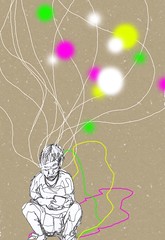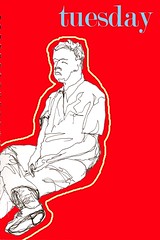(Drawings and pics of the trip coming up soon when I get back home!)
The night before last my colleagues and I got lost in Venice. And I thought of
Calvino's Invisible Cities.
As it was still early after dinner, we had taken a meandering, leisurely walk through Venice's narrow alleyways towards the city's edge to catch a ferry back to Lido island. We did not know where exactly we were, or which pier we would eventually find. And when we did hear the gentle lapping of the water against the city's edge, we did find a pier. It was not a pier we recognised, but the sign said that one of the ferries would be headed to Lido. We were surprised by our good luck.
We waited about 20mins before the ferry arrived and boarded it. It chugged slowly off and sputtered to a stop along the way at some other quiet piers. The ride was taking longer than we had expected. But the air was cool, and in the darkness, who knows where we were all going anyway?
Then each stop grew more quiet. The lights, if there were any, were lonely. It was ten and night finally relented to dark. And when we finally grew a little concerned, the ferry did a last sputter. The ferry attendant declared the name of the stop - we did not know what, except that it was clearly not Lido. We trooped off the ferry. The cool air turned chilly, and the romance of not knowing was now decidedly less charming.
"Hey," one of us suddenly exclaimed, "we are back exactly where we started!"
Of course! I wanted to laugh. There was a humour in this, this returning. In Venice, this cinematic city - more imagined than real - returning seemed an apt narrative strategy. But there were more pressing concerns, such as getting back to Lido before the ferry services stopped or, in fact, finding out exactly where we were and how we should get back.
The attendant advised "Go
San Marco, San Marco -", naming the famous central square. "Follow the signs, all go to San Marco!"
We tried to follow the signs, painted on the walls of some of the buildings. Until the signs disappeared. Each turn brought us to a new small square, a new nexus of little alleys, or another bridge - and the question "to cross?" Each alley seemed similar and familiar, but never entirely. Time was a minotaur - and smaller minotaurs were the blisters on some of our tired feet.
There was no surprise ending. It was, as expected, happy - the expansive and busy San Marco square did, after some 20 minutes or so of frantic wandering, opened up suddenly before us.

In Calvino's collection of vignettes, his narrator/traveller is Marco Polo, whose home, of course, is none other than Venice. In fact, Calvino gives Marco Polo this line - “Every time I describe a city I am saying something about Venice.”
Perhaps it is apt that Venice should host
one of the world's oldest international art shows. However abstract, art returns to and is understood always in context - whether its own, its creating or its audience - immediate or distant.
Today, I left Venice and arrived in Kassel, the German city for Documenta 12 - that other contemporary art show. It is a tranquil, slow - even bland - city, so unlike the over-heated Venice. But Kassel was not always tranquil. It was the site of a subcamp of Dachau concentration camp during WWII. In 1943, it was heavily bombed, most of its city centre reduced to rubble. The first Documenta in 1955 was perhaps a response to all this - an attempt to show art amidst ruins and against the recent past.

















